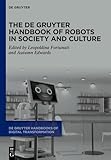The De Gruyter Handbook of Robots in Society and Culture / ed. by Leopoldina Fortunati, Autumn Edwards.
Material type: TextSeries: De Gruyter Handbooks of Digital Transformation ; 3Publisher: Berlin ; Boston : De Gruyter, [2024]Copyright date: 2024Description: 1 online resource (VII, 494 p.)Content type:
TextSeries: De Gruyter Handbooks of Digital Transformation ; 3Publisher: Berlin ; Boston : De Gruyter, [2024]Copyright date: 2024Description: 1 online resource (VII, 494 p.)Content type: - 9783110792157
- 9783110792331
- 9783110792270
- 303.483
- online - DeGruyter
- Issued also in print.
| Item type | Current library | Call number | URL | Status | Notes | Barcode | |
|---|---|---|---|---|---|---|---|
 eBook
eBook
|
Biblioteca "Angelicum" Pont. Univ. S.Tommaso d'Aquino Nuvola online | online - DeGruyter (Browse shelf(Opens below)) | Online access | Not for loan (Accesso limitato) | Accesso per gli utenti autorizzati / Access for authorized users | (dgr)9783110792270 |
Frontmatter -- Contents -- Introduction -- Section 1: Robots in Culture and Society -- Future Presence: Living with Social Robots -- Representing Robots in Popular Culture -- Designing Robots That are Accepted in Human Social Environments: Anthropomorphism, the Intentional Stance, Cultural Norms and Values, and Societal Implications -- Are Robotic Bodies (Part of) Social Bodies? -- Persons or Things: The Role of Robots in Society -- Automated Masspersonal Social Engineering -- Section 2: Humanistic and Social Scientific Perspectives -- Linguistics -- AI and Human Writing: Collaboration or Appropriation? -- Law -- Policies, Regulation, and Legal Perspectives on Social Robots -- How Social Robots Affect Privacy: Navigating the Landscape -- Sociology -- Artificial Intelligence, Robotics, and the Evolution of the Social Sciences -- Human Interactions With (Embodied) AI: The Future of Authenticity in Human–AI Relation(ship)s -- Psychology and Neuroscience -- Mind Perception During and After Interacting with Artificial Agents -- How People Perceive Social Robots: The Case of Gender -- Relating with Social Robots: Issues of Sex, Love, Intimacy, Emotion, Attachment, and Companionship -- Real or Pretend? How Children Ontologize Social Robots as Mental and Moral Others -- Communication and Computer Sciences -- Rethinking Communication between Humans and Social Robots -- Interacting with Social Robots: The Influence of their Distinctive Cues, Behavioral Capabilities, and Affordances on Social Interaction and Well-being -- Integrating Big-Data Tools to Study AI and Human–Machine Communication: Methodology Strengths, Future Directions, and Applications -- Social Robots and Children: A Field in Development -- Section 3: Contexts of Human–Robot Interaction -- Anthropomorphizing Voice Assistants: A Research Agenda for Human–AI Relationships -- Domestic Appliances and Household Robots: The Changing Landscape of Housework and Family -- Ability and Disability: Social Robots and Accessibility, Disability Justice, and the Socially Constructed Normal Body -- Growing Old Together: The Promise and Challenge of Social Robots for Older Adults -- Power and Synchrony in Human Collaboration with Exoskeletons -- Index
restricted access online access with authorization star
http://purl.org/coar/access_right/c_16ec
The De Gruyter Handbook of Robots in Society and Culture provides a comprehensive discussion of how social robots take form, function, and meaning for individuals, relationships, cultures, and societies. Through a path-breaking integration of perspectives coming from sociology, communication and media, psychology, cognitive neuroscience, anthropology, political science, and science and technology studies, it focuses on the critical and social meaning of present developments in social robotic technologies. This book looks at artificial agents – from voice-based assistants to humanoid robots— as their use transforms private and public contexts and gives rise to both new possibilities and new perils for human being and becoming, organizations as well as social structures and institutions. The handbook traces the consequences and key problems of social robotics across broad social contexts in both public and political as well as domestic and intimate spaces. Further, it attends carefully to the implications of social robotics for various human identity groups, including those based on gender, ethnicity, culture, class, ability, and age. Deep attention to interdisciplinarity, inclusivity, ethics, and socio-cultural futures serves as the guiding inspiration behind each contribution within this handbook.
Issued also in print.
Mode of access: Internet via World Wide Web.
In English.
Description based on online resource; title from PDF title page (publisher's Web site, viewed 20. Nov 2024)


